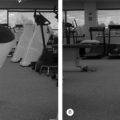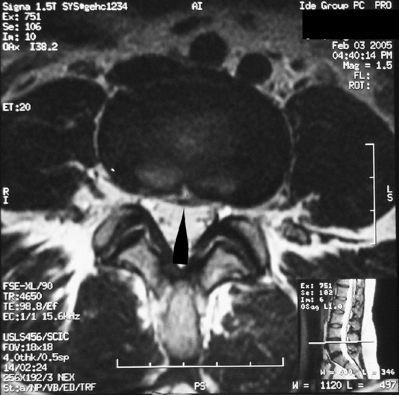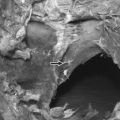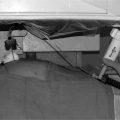CHAPTER 66 Cervical Spine
CERVICAL ZYGOAPOPHYSEAL PAIN
Clinical syndrome
Patients with cervical zygapophyseal (facet) joint pain present commonly with a dull and aching bilateral neck pain. Pain emanating from the cervical facet joints can refer into the occiput, interscapular, or shoulder girdle regions dependent on the cervical facet joint involved in the patient’s pain syndrome.1–4 Pain from the higher cervical facet joints may end up causing cervicogenic headache.5 On physical examination one may find a reduced range of motion of the cervical spine if the higher facet joints are involved. Marked paravertebral tenderness to palpation suggests regional soft tissue changes in response to the underlying injured facet joint, but these findings are not pathognomonic. X-rays, computed tomography (CT), and magnetic resonance imaging (MRI) scans may reveal morphological abnormalities; however, there is no direct relationship between anatomical findings and pain.6–8
Indications and contraindications
The indications to perform a radiofrequency (RF) denervation of the medial branches that innervate the cervical facet joints are identical for nontraumatic and post-traumatic neck pain. In whiplash-associated cervical pain the periosteal tearing of the facet joints due to muscle ligamentous sprain is thought to be the most common cause of neck pain.9–11
Cervicogenic headache (CH) is another possible indication of performing an RF denervation of the medial branches of the cervical facet joints. It is typically described as a unilateral headache localized in the neck or occipital region and sometimes projecting to the forehead. The referred pain originates from the cervical structures, which in some instances is singularly from the facet joints. This distinct headache syndrome was described as early as 1926. Sjaastad et al. were the first to name it CH and to propose diagnostic criteria.5,12 RF denervation of the cervical medial branches tend to reduce nociceptive output from structures such as spinal facet joints and spinal nerve roots, so this intervention has been proposed to be an effective treatment of CH.13
Side effects and complications
A common side effect (in 13% of the patients) of the RF denervation of cervical facet joints is a transient increase in pain in the neck that resolves in 2–6 weeks.14 Vervest and Stolker also reported 4% of patients with occipital hypesthesia, which resolves in 3 months. They suggest this side effect is caused by a lesion of the third occipital nerve. Another side effect that is described after RF denervation of the third occipital nerve is a transient ataxia and unsteadiness, probably secondary to a partial blockade of the upper cervical proprioceptive afferents.3
Outcomes
In 1980, Sluijter and Koetsveld-Baart15 concluded that RF lesioning of the cervical facet joints and/or dorsal root ganglion can be of considerable help in a selected group of patients. This judgment was based on observing 61% of patients obtaining in excess of 40% symptom relief following RF, while obtaining no benefit from prior treatments. In an open prospective study in 1995, Lord et al. evaluated the pain relief in the upper and lower cervical region using RF lesions of the medial branch of the posterior primary ramus (RF-PFD) in 19 patients using a posterior approach.16 Patient selection was based on comparative local anesthetic blocks. The procedure was effective in the lower region in 7 of 10 (70%) patients but only in 4 of 9 (44%) patients in the higher region, i.e. the C2–3 facet joint. That study concluded that the encouraging results of RF lesions at the medial branch of the dorsal ramus at the lower cervical levels justified a randomized, double-blind, controlled trial.
One year later, Lord et al. performed a randomized, double-blind, controlled trial in patients with chronic pain of the lower cervical facet joints after whiplash injury.11 This study revealed that, in patients with chronic facet joint pain, confirmed with double-blind, placebo-controlled local anesthetic blocks, percutaneous RF neurotomy with multiple lesions of target nerves could provide lasting pain relief and was not a placebo effect.
In 1999, McDonald et al.17 published a double-blinded, controlled study to determine the long-term efficacy of percutaneous radiofrequency medial branch neurotomy in the treatment of chronic neck pain. They only performed the neurotomy (using the posterior parasagittal approach) in patients with a positive response to either comparative or placebo-controlled blocks. Their conclusion was that the relief of neck pain obtained by percutaneous radiofrequency neurotomy can be clinically satisfying, but of limited duration. They also stated that the effects of these procedure could be reinstated if pain recurs.
The prospective study of Sapir and Gorup, published in 2001,18 compared the efficacy of radiofrequency medial branch neurotomy to treat cervical zygapophyseal joint pain in patients with whiplash who were either litigants or nonlitigants. They found no difference in outcomes following radiofrequency treatment in patients with the potential of secondary gain. They also concluded that radiofrequency neurotomy is efficacious for the treatment of traumatic cervical facet arthropathy.
Geurts et al. concluded that there is limited evidence for RF facet denervation in the treatment of chronic cervical pain following a whiplash event.19
Radiofrequency lesioning of the cervical facet joints in the treatment for neck pain and headache was performed in several studies.20,21 These studies suggest that RF can offer a tangible benefit, but that the results are modest and not compelling. In a recent open prospective study, Van Suijlekom et al. evaluated the effect of headache relief in patients with cervicogenic headache after RF-PDF at the levels C3–6.13 In that study the lateral approach was used. They demonstrated that RF cervical facet denervation leads to a significant reduction in headache severity, number of days with headache, and analgesic intake in patients with cervicogenic headache diagnosed according to the criteria of Sjaastad et al.5 In 2004 Stovner et al. published a randomized, double-blind, sham-controlled study to determine whether RF denervation of facet joints C2–3 could be a good treatment of cervicogenic headache.22 They could include only 12 patients in total and did a follow-up of 24 months. They found some improvement in the neurotomy group at 3 months, but later on there were no marked differences between the RF group and the sham group. Their conclusion was that the procedure is probably not beneficial in cervicogenic headache.
CERVICAL RADICULAR PAIN
Clinical syndrome
Cervicobrachialgia is a widespread pain syndrome. Bland estimates that 9% of all men and 12% of all women experience this pain at some times in their lives.23 In 1994, Radhakrishnan et al. published a population-based survey.24 In this epidemiological survey an annual incidence of cervical radiculopathy of 83.2 per 100 000 in a population between 13 and 91 years was found.
The pain in cervicobrachialgia is described as a continuous, dull aching pain in the neck (most commonly localized in the mid- and lower cervical area) traveling beyond the gleno-humeral joint into the arm with referral to a particular spinal segment. Segmental pain in the upper extremity can be related to discogenic pathology such as a cervical disc protrusion or irritation of the spinal nerve. Spinal nerve irritation can be caused by narrowing of the intervertebral foramen by spondylosis. The most common nerve levels involved, are C6 and C7 and less C5. The levels C4 and C8 are uncommon. The involved spinal level can be estimated by the dermatome in which the pain is radiating and can be determined by prognostic nerve blocks.25–27
In the International Association for the Study of Pain (IASP) classification of chronic pain, Merskey and Bogduk considered radicular pain and radiculopathy as two distinct entities.28 Cervical radicular pain is defined as pain perceived as arising in the upper limb caused by ectopic activation of nociceptive afferent fibers in a spinal nerve or its roots or other neuropathic mechanisms. Cervical radiculopathy is defined as the objective loss of sensory and/or motor function as a result of conduction block in axons of a spinal nerve or its roots. The two conditions may nonetheless coexist and may be caused by the same lesion, or radiculopathy may follow radicular pain in the course of the disease. Ectopic activation may occur as a result of mechanical deformation of a dorsal root ganglion (DRG), mechanical stimulation of previously damaged nerve roots, inflammation of a DRG, and possibly by ischemic damage of DRG.28–31 Any lesion that causes conduction block in axons of a spinal nerve or its roots, either directly by mechanical compression of the axons or indirectly by compromising their blood supply and nutrition, may be the cause of radiculopathy.
Many authors state that cervical radicular pain is a common clinical diagnosis.32–35 As with other types of spinal pain, if the pain does not spontaneously resolve within 3 months, medical diagnoses such as vertebral column infection and cancer should be considered before further symptomatic treatment is offered. Furthermore, abnormalities that may benefit from percutaneous disc decompression or an open surgical procedure, such as cervical disc prolapse or other serious pathological abnormalities should be excluded before radiofrequency DRG is performed.
In medical history, the location and pattern of pain, altered sensation or paresthesias, and motor deficits were thought to be definitive for cervical radicular pain.36–38 As described elsewhere in this book, there are numerous instances in which the painful symptoms are located in region that is not classically associated with a particular nerve.
Neurological examination includes testing of strength, muscle stretch reflexes, and sensation.39 The cervical range of motion is frequently assessed when examining patients with complaints of neck pain and these measurements may be used as an indicator of treatment effectiveness.40,41 Provocative tests for patients with cervical radicular pain and radiculopathy may induce or alleviate mechanical deformation by the following mechanisms: enlargement or narrowing of the neural foramen,42,43 peripheral neural elements placed on slack or stretch,44–46 and an increase in intrathecal pressure.47 Five different provocative tests have been reported as useful for the diagnosis of cervical radicular pain: (1) Spurling’s test,42 (2) shoulder abduction test,44 (3) Valsava’s maneuver,47 (4) neck distraction,48 and (5) Elvey’s upper limb tension test.46
The Spurling test is one of the few clinical tests that has been validated in a controlled trial using electromyography (EMG) as confirmation. This test had a sensitivity of 30% but a specificity of 93%, illustrating its value in confirming cervical radicular pain and radiculopathy.49
The primary role of plain radiography is to rule out other insidious disease processes and the delineation of osteophytes when used in conjunction with MRI.50,51 Myelography is used to assess the effect of a space-occupying lesion on the dural sac, the nerve roots, and the spinal cord.52 A CT scan is particularly useful for enhancement of bony margins. It is more sensitive than MRI to bony changes but has limited ability to detect soft tissue lesions.50,53,54 MRI is noninvasive and more sensitive to changes of the disc, spinal cord, nerve root, and surrounding soft tissue structures.53 Some authors state that MRI is the imaging method of choice, which appears to be consistent with current practice patterns.55
Because imaging procedures may show a number of dramatic abnormalities that produce no signs or symptoms, interpretation of any imaging finding must be done in the context of the patient’s clinical presentation.56
Although often collectively referred to as electromyography (EMG), in practice the electrophysiological examination consists of needle electromyography and a variety of evoked potential procedures. Needle electromyography is used to sample motor unit behavior in selected limb muscles as well as the cervical paravertebral muscles in order to detect neural pathophysiology and localize it to a cervical nerve root or roots.57 Nerve conduction studies are also performed in conjunction with EMG in order to rule out other causes of symptoms such as a diffuse peripheral neuropathy or more distal mononeuropathy.57
All diagnostic modalities provide excellent information of the morphological pathology and its relation to the neuraxis but do not reveal its clinical significance. Therefore, selective diagnostic nerve root blocks are recommended before deciding which level should be treated. The technique, injecting a local anesthetic adjacent to the DRG, controlled by means of contrast injection, has been described by van Kleef et al.25
Indications and contraindications
The indications to perform a radiofrequency (RF) lesioning of a cervical DRG differ from level to level.58 It must be emphasized that a diagnostic segmental cervical nerve block always has to be performed prior to an RF procedure to predict the effect of blocking a certain segmental nerve and to identify the involved level(s). The C2 and C3 levels are performed for cervicogenic- and neck-related headache, for post-traumatic headache, and in cases where there is persisting pain in the suboccipital region or the upper neck region after a noneffective medial branch procedure. The C2 level is also performed in true occipital neuralgia with sensory loss in the C2 dermatome. An indication for the level C4 is really exceptional. The C5, C6, C7, and C8 levels can be performed in cases of acute herniation at the involved level with clinically significant radicular pain. This may occur when radiculopathy results from narrowing of the foramen, although uncommon at the C8–T1 level, or when there is a clearly defined radicular pain without any anatomical findings. Lastly, a C5 dorsal root ganglion RF treatment can be performed, as described by Sluijter, when there is shoulder pain caused by pathology in or around the joint.
The contraindications are the same as described above in the part ‘Cervical zygapophyseal pain.’
Side effects and complications
A side effect that is often seen (40–60%) is a mild burning sensation (some deep neck soreness) in the treated dermatome that subsides spontaneously within 1–3 weeks.25 Some sensory changes, such as a slight hypesthesia may occur, but invariably disappears within 3–4 months.59,60
Outcomes
In 1991, Vervest and Stolker published a retrospective study in 53 patients with prolonged cervical pain eventually radiating to the occipital region, head, shoulder, or arm not responding to conservative treatment.14 If there was local tenderness at the facet joints, a percutaneous cervical facet joint denervation was performed. If this was not successful and there was cervical pain with referral to the occipital region or arm, indicating segmental irritation, diagnostic segmental nerve blocks were performed. A positive diagnostic block was followed by an RF-DRG. The results were good to excellent in 80.5% of treatments. After a follow-up of 1.5 years 44 patients (84.5%) still had satisfactory pain relief.
Van Kleef et al. investigated the outcomes following the performance of this procedure in the cervical region. In an open prospective study of 20 consecutive patients with chronic intractable pain in the cervical region with referral to the head, shoulder, and/or arm, RF-DRG provided pain relief in 75% of patients at 3 months and in 50% of patients at 6 months.61 The results revealed that initial pain relief was acceptable, but there was a tendency for pain to recur at 3–9 months. In 1996, Van Kleef et al. showed that RF lesions adjacent to the DRG for cervicobrachial pain could result in a significant alleviation of pain in chronic cervicobrachial pain.25 In this prospective, double-blind, randomized study, the outcomes revealed a positive benefit during the first 8 weeks after the procedure. Slappendel et al. suggested, in a recent double-blind, randomized study with follow-up of 3 months, that treatment with 40°C RF application to the DRG is equally effective as treatment at 67°.59
In a recent systematic review Geurts et al. concluded that there is limited evidence that RF-DRG is more effective than placebo in chronic cervicobrachialgia.19 Niemisto et al. performed a systematic review and arrived at the same conclusion.62 In 2003, Van Zundert et al. published a clinical audit of 18 patients with cervicogenic headache or cervicobrachialgia who failed conservative treatment. This cohort underwent PRF, the least destructive RF modification adjacent to the involved cervical DRG.60 In 72% of the patients there was a minimum reduction of pain at least 50% at 8 weeks. At 1 year 33% of the patients continued to report the treatment outcome as good or very good. There were no neurological side effects or complications observed.
1 Dwyer A, Aprill C, Bogduk N. Cervical zygapophyseal joint pain patterns. I: A study in normal volunteers. Spine. 1990;15(6):453-457.
2 Aprill C, Dwyer A, Bogduk N. Cervical zygapophyseal joint pain patterns. II: A clinical evaluation. Spine. 1990;15(6):458-461.
3 Bogduk N, Marsland A. The cervical zygapophyseal joints as a source of neck pain. Spine. 1988;13(6):610-617.
4 Fukui S, Ohseto K, Shiotani M, et al. Referred pain distribution of the cervical zygapophyseal joints and cervical dorsal rami. Pain. 1996;68:79-83.
5 Sjaastad O, Fredriksen TA, Pfaffenrath V. Cervicogenic headache: diagnostic criteria. Headache. 1990;30(11):725-726.
6 Gore D, Sepsic S, Gardness G. Roentgenographic findings of the cervical spine in asymptomatic people. Spine. 1986;11(6):521-524.
7 Schellhas KP, Smith MD, Gundry CR, et al. Cervical discogenic pain. Prospective correlation of magnetic resonance imaging and discography in asymptomatic subjects and pain sufferers. Spine. 1996;21(3):300-311.
8 Mayer E, Hermann G, Pfaffenrath V. Functional radiographics of the craniocervical region and the cervical spine. A new computer-aided technique. Cephalalgia. 1985;5(4):237-243.
9 Barnsley L, Lord S, Wallis B, et al. The prevalence of chronic cervical zygapophyseal joint pain after whiplash. Spine. 1995;20(1):20-26.
10 Lord S, Barnsley L, Wallis B, et al. Chronic cervical zygapophyseal joint pain after whiplash. A placebo-controlled prevalence study. Spine. 1996;21(15):1737-1745.
11 Lord SM, Barnsley L, Wallis BJ, et al. Percutaneous radio-frequency neurotomy for chronic cervical zygapophyseal-joint pain. N Engl J Med. 1996;335(23):1721-12726.
12 Barre M. Sur un syndrome sympathique cervical posterieur et sa cause frequente: l’arthritide cervicale. Rev. Neurol. 1926;33:1246-1248.
13 van Suijlekom HA, van Kleef M, Barendse GA, et al. Radiofrequency cervical zygapophyseal joint neurotomy for cervicogenic headache: a prospective study of 15 patients. Funct Neurol. 1998;13(4):297-303.
14 Vervest A, Stolker R. The treatment of cervical pain syndromes with radiofrequency procedures. Pain Clin. 1991;4:103-112.
15 Sluijter ME, Koetsveld Baart CC. Interruption of pain pathways in the treatment of the cervical syndrome. Anaesthesia. 1980;35(3):302-307.
16 Lord SM, Barnsley L, Bogduk N. Percutaneous radiofrequency neurotomy in the treatment of cervical zygapophyseal joint pain: a caution. Neurosurgery. 1995;36(4):732-739.
17 McDonald G, Lord S, Bogduk N. Long-term follow-up of patients treated with cervical radiofrequency neurotomy for chronic neck pain. Neurosurgery. 1999;45(1):61-68.
18 Sapir A, Gorup J. Radiofrequency medial branch neurotomy in litigant and nonlitigant patients with cervical whiplash. Spine. 2001;26(12):E268-E273.
19 Geurts JW, van Wijk RM, Stolker RJ, et al. Efficacy of radiofrequency procedures for the treatment of spinal pain: a systematic review of randomized clinical trials. Regl Anesthes Pain Med. 2001;26(5):394-400.
20 Hildebrandt J. Percutaneous nerve block of the cervical facets – a relatively new method in the treatment of chronic headache and neck pain. Man Med. 1986;2:48-52.
21 Schaerer JP. Radiofrequency facet rhizotomy in the treatment of chronic neck and low back pain. Internat Surg. 1978;63(6):53-59.
22 Stovner L, Kolstad F, Helde G. Radiofrequency denervation of facet joints C2–C6 in cervicogenic headache: A randomized, double-blind, sham-controlled study. Cephalagia. 2004;24:821-830.
23 Bland J. Cervical spine syndromes. J Muskuloskel Med. 1986;3:23-41.
24 Radhakrishnan K, Litchy W, O’Fallon W, et al. Epidemiology of cervical radiculopathy. A population-based study from Rochester, Minnesota, 1976 through 1990. Brain. 1994;117(Pt 2):325-335.
25 van Kleef M, Liem L, Lousberg R, et al. Radiofrequency lesion adjacent to the dorsal root ganglion for cervicobrachial pain: a prospective double blind randomized study. Neurosurgery. 1996;38(6):1127-1131.
26 Van Kleef M, Sluijter M. Radiofrequency lesions in the treatment of pain of spinal origin. In: Gildenberg P, Tasker R, editors. Textbook of stereotactic and functional neurosurgery. New York: McGraw-Hill; 1998:1585-1599.
27 Stolker R, Groen G. Clinical review: The management of chronic spinal pain by blockades: a review. Pain. 1994;58:1-20.
28 Merksey H, Bogduk N, (eds). Classification of chronic pain: Descriptions of chronic pain syndromes and definitions of pain terms. Monograph for the Sub-Committe on Taxonomy, International Association for the Study of Pain. 2nd edn. Seattle, International Association for the Study of Pain.
29 Howe J, Loeser J, Calvin W. Mechanosensitivity of dorsal root ganglia and chronically injured axons: a physiological basis for the radicular pain of nerve root compression. Pain. 1977;3:25-41.
30 Howe J. A neurophysiological basis for the radicular pain of nerve root compression. New York: Raven Press, 1979.
31 Murphy R. Nerve roots and spinal nerves in degenerative disk disease. Clin Orthop. 1977;12(129):46-60.
32 Ahlgren B, Garfin S. Cervical radiculopathy. Orthop Clin North Am. 1996;27:253-263.
33 An H. Cervical root entrapment. Hand Clin. 1996;12:719-730.
34 Ellenberg M, Honet J, Treanor W. Cervical radiculopathy. Arch Phys Med Rehabil. 1994;75:342-352.
35 Caplan L. Management of cervical radiculopathy. Eur Neurol. 1995;35:309-320.
36 Cloward R. Cervical diskography. A contribution to the etiology and mechanism of neck, shoulder and arm pain. Ann Surg. 1959;150:1052-1064.
37 Michelsen J, Mixter W. Pain and disability of shoulder and arm due to herniation of the nucleus pulposus of cervical intervertebral disks. N Engl J Med. 1944;231:279-287.
38 Warfield C, Biber M, Crews D, et al. Epidural steroid injection as a treatment for cervical radiculitis. Clin J Pain. 1988;4:201-204.
39 Fager C. Identification and management of radiculopathy. Neurosurg Clin N Am. 1993;4:1-12.
40 Youdas J, Carey J, Garrett T. Reliability of measurements of cervical spine range of motion – comparison of three methods. Phys Ther. 1991;71:98-104. discussion 105–106
41 Lowery WJr, Horn T, Boden S, et al. Impairment evaluation based on spinal range of motion in normal subjects. J Spinal Disord. 1992;5:398-402.
42 Muhle C, Bischoff L, Weinert D, et al. Exacerbated pain in cervical radiculopathy at axial rotation, flexion, extension, and coupled motions of the cervical spine: evaluation by kinematic magnetic resonance imaging. Invest Radiol. 1998;33:279-288.
43 Spurling R, Scoville W. Lateral rupture of the cervical intervertebral discs: a common cause of shoulder and arm pain. Surg Gynecol Obstet. 1944;78:350-358.
44 Davidson R, Dunn E, Metzmaker J. The shoulder abduction test in the diagnosis of radicular pain in cervical extradural compressive monoradiculopathies. Spine. 1981;6:441-446.
45 Elbey R. The investigation of arm pain: signs and adverse responses to the physical examination of the brachial plexus and related tissues. New York: Churchill Livingstone, 1994.
46 Saal J, Saal J, Yurth E. Nonoperative management of herniated cervical intervertebral disc with radiculopathy. Spine. 1996;21:1877-1883.
47 Rothstein J, Roy S, Wolf S. The Rehabilitation Specialist’s Handbook. Philadelphia: FA Davis, 1991.
48 Viikari-Juntura E, Porras M, Laasonen E. Validity of clinical tests in the diagnosis of root compression in cervical disc disease. Spine. 1989;14:253-257.
49 Tong H, Haig A, Yamakawa K. The Spurling test and cervical radiculopathy. Spine. 2002;27:156-159.
50 Brown B, Schwartz R, Frank E, et al. Preoperative evaluation of cervical radiculopathy and myelopathy by surface-coil MR imaging. Am J Roentgenol. 1988;151:1205-1212.
51 Nakstad P, Hald J, Bakke S, et al. MRI in cervical disk herniation. Neuroradiology. 1989;31:382-385.
52 Wilmink J. Clinical relevance of cervical disk herniation diagnosed on the basis of MR imaging. Am J Neuroradiol. 1989;10:1278-1279.
53 Jahnke R, Hart B. Cervical stenosis, spondylosis, and herniated disc disease. Radiol Clin North Am. 1991;29:777-791.
54 Modic M, Masaryk T, Mulopulos G, et al. Cervical radiculopathy: prospective evaluation with surface coil MR imaging, CT with metrizamide, and metrizamide myelography. Radiology. 1986;161:753-759.
55 Wainner R, Gill H. Diagnosis and nonoperative management of cervical radiculopathy. J Orthop Sports Phys Ther. 2000;30:728-744.
56 Healy J, Healy B, Wong W, et al. Cervical and lumbar MRI in asymptomatic older male lifelong athletes: frequency of degenerative findings. J Comput Assist Tomogr. 1996;20:107-112.
57 Dimitru D. Electrodiagnostic medicine. Philadelphia: Hanley & Belfus, 1995.
58 Sluijter M. The medial branch procedure. In: Sluijter M, editor. Radiofrequency Part 2: Thoracic and cervical region, headache and facial pain. Meggen, SA: Flivo Press; 2003:99-110.
59 Slappendel R, Crul BJ, Braak GJ, et al. The efficacy of radiofrequency lesioning of the cervical spinal dorsal root ganglion in a double blinded randomized study: no difference between 40 degrees C and 67 degrees C treatments. Pain. 1997;73(2):159-163.
60 van Zundert J, Lamé I, de Louw A, et al. Percutaneous pulsed radiofrequency treatment of the cervical dorsal root. ganglion in the treatment of chronic cervical pain syndromes: a clinical audit. Neuromodulation. 2003;6(1):6-14.
61 van Kleef M, Spaans F, Dingemans W, et al. Effects and side effects of a percutaneous thermal lesion of the dorsal root ganglion in patients with cervical pain syndrome. Pain. 1993;52(1):49-53.
62 Niemisto L, Kalso E, Malmivaara A, et al. Radiofrequency denervation for neck and back pain: a systematic review within the framework of the Cochrane Collaboration Back Review Group. Spine. 2003;28(16):1877-1888.







